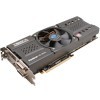- Qualcomm Launches Snapdragon 4 Gen 2 Mobile Platform
- AMD Launches Ryzen PRO 7000 Series Mobile & Desktop Platform
- Intel Launches Sleek Single-Slot Arc Pro A60 Workstation Graphics Card
- NVIDIA Announces Latest Ada Lovelace Additions: GeForce RTX 4060 Ti & RTX 4060
- Maxon Redshift With AMD Radeon GPU Rendering Support Now Available
Sapphire Radeon HD 5870 Vapor-X

It’s no secret that the Radeon HD 5870 is the fastest GPU on the planet, but what do you get when you take it, toss in a more robust cooler, quieter operation, higher clock speeds and not one, but two free games? You get the Vapor-X, from Sapphire. Despite all that it packs in above the reference version, it modestly carries just a $20 premium.
Page 11 – Overclocking Sapphire’s HD 5870 Vapor-X
Before tackling our overclocking results, let’s first clear up what we consider to be a real overclock and how we go about achieving it. If you read our processor reviews, you might already be aware that we don’t care too much for an unstable overclock. It might look good on paper, but if it’s not stable, then it won’t be used. Very few people purchase a new GPU for the sole purpose of finding the maximum overclock, which is why we focus on finding what’s stable and usable.
To find the max stable overclock on an ATI card, we stick to using ATI’s Catalyst Overdrive tool. Compared to what’s available on the NVIDIA side, it’s quite limited in the top-end, but it’s the most robust and simplest solution to use. For NVIDIA, we use EVGA’s Precision, which allows us to reach heights that are in no way sane – a good thing.
Once we find what we believe might be a stable overclock, the card is put through 30 minutes of torture with the help of OCCT 3.0’s GPU stress-test, which we find to push any graphics card harder than any other stress-tester we’ve ever used. If the card passes there, we then further verify by running the card through a 2x run of 3DMark Vantage’s Extreme setting. Finally, games are quickly loaded and tested out to assure we haven’t introduced any side-effects.
If all these tests pass without issue, we consider the overclock to be stable.
Overclocking Sapphire’s Radeon HD 5870 Vapor-X
Sapphire’s Vapor-X, as mentioned in the intro, is clocked a wee bit above reference. And I do mean just a “wee bit”. The reference clocks are 850MHz/1200MHz, while the Vapor-X’s is 870MHz/1250MHz. So with such a minor overclock, and superb GPU cooler, it could be assumed that we could push the card quite a bit further. But… not so much. The overclocking utility that’s bundled with ATI’s control center, Overdrive, is needlessly restrictive, as it disallows us to go higher than 900MHz/1300MHz. So, not surprisingly, that proved to be our max stable overclock.


I have never found a GPU overclock that I considered useful, but the gains here aren’t too bad given the minor bump in frequencies we made. But, whether or not these minor gains are worth the extra stress and heat (both equally as minor) is up to you. The Vapor-X card is unbelievably fast even with its “stock” clocks, so as whole, the need to overclock the card doesn’t exist. My opinion on that would change if ATI’s control center would allow us to go higher than 900MHz/1300MHz. I really hope to see ATI loosen its restrictions there in the future, as NVIDIA cards (using non-NVIDIA tools) have virtually no limit.
Support our efforts! With ad revenue at an all-time low for written websites, we're relying more than ever on reader support to help us continue putting so much effort into this type of content. You can support us by becoming a Patron, or by using our Amazon shopping affiliate links listed through our articles. Thanks for your support!





